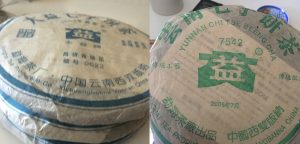Help identify this cake (generic Zhongcha wrapper). Help me with my order from White2Tea/Yunnan Sourcing/TWL? What’s a genuine pu’erh source? What pu’erh should I try?
Sometimes I feel like parts of the tea community (reddit) are stuck in a Groundhog day time loop, doomed to ask the same questions over and over. One of my continued aims with TeaDB was to make content that remained useful and helpful over time and help get out of repeated patterns. The results have been mixed. Some articles I still see linked regularly whereas I’m sure a huge chunk are buried in the archives. The aim with this post is to create a guide for someone just journeying into pu’erh in selecting and exploring this diverse category of tea.

If You Are A Beginner You Should Try These Five Types of Raw Pu’erh
There are large differences based off terroir, processing, age and storage. Some things matter considerably more than others, and if you are new it’s important to cut through the massive info dump (who cares which micro village it’s from) and get the most important basics down.
This is my preferred way of breaking down the categories of raw pu’erh for someone new.
- Young Boutique Raw Pu’erh – There’s a ton of different smallish outfits making young pu’erh. Young pu’erh will brew a lighter, yellowish color and have lighter, fresher, more floral profile. It can be pleasant now and there’s definitely a large group of pu-heads that drink these regularly. It was and perhaps still is the dominant type of pu’erh promoted to westerners. White2Tea, Yunnan Sourcing, Farmer Leaf, Chenyuan Hao, etc. Not all brands are the same, but you really have to try them to determine which brand and areas suits you best.Why not young factory pu’erh? While there is a general sentiment that these have gotten easier and smoother to drink, these are historically teas for storage and aging. For the sake of simplicity I would not bother trying these until later.
- Semi-Aged (10-20 years old) Factory Raw Pu’erh Stored in a Hot + Humid Place – An important aspect to pu’erh is its ability to transform. Different climates and different storage methodologies will yield different results. Hotter and more humid areas will transform the tea more quickly. These teas should brew darker than younger tea, orange or even red. Generally they will become smoother over time.It’s important to note that humid is relative with most of the defaults being significantly hotter and humid than your average western climate. The United Kingdom or Pacific Northwest reputation aside do not qualify as humid in this case. (a) Hot + Humid place = Guangdong, Taiwan, Malaysia, Xishuangbanna, etc.. (b) Factory = Menghai Tea Factory, Xiaguan, Mengku, etc. Menghai Tea Factory is probably the ideal factory although different people have different factory preferences. The ideal: 2005-2011 Menghai TF tea stored in Taiwan.
- Semi-Aged (10-20 years old) Factory Raw Pu’erh Stored in a Cool + Dry Place – While age will generally smooth and darken pu’erh, drier climates in general will result in a slower transformation and keep the original character of the more tea intact. Teas in this category will have a darker color than young tea, but not as much as 2.
- Semi-Aged (10-20 years old) Boutique Raw Pu’erh – The more aged version of tea type 1. One hurdle is a lot of the western facing boutiques have not been around that long. Semi-Aged boutique tea is probably easier to find from Taiwan-based vendors which has a high number of boutique vendors that are accessible to the west.. You can also find more dryly stored examples. Example: 2007 Chenyuan Hao Yiwu.
- Traditionally Stored Raw Pu’erh (10+ Years Old) – This is an important type of tea that is different from what people sometimes disparagingly call wet storage. Read about traditionally stored pu’erh on Marshaln’s blog. Generally this will brew the darkest of all the categories, reddish. Traditionally stored pu’erh is the most difficult type to find. It is important to try as traditional storage transforms pu’erh in a different manner than more natural Taiwan/Guangdong/Malaysia/Hong Kong. While there are some more indie vendors that have some traditionally stored tea, the biggest, most reliable place to get traditionally stored tea remains HK-Based Yee On who is a traditional storage specialist.

Samples & How Many Should I Get?
If possible, order samples! Samples cost a little more per gram, but getting the extra value from a full cake is relatively unimportant compared with getting good examples for the tea you want to try. Getting a good baseline for these categories of tea is an essential step in moving forward. It is more important to get good experiences from a diversity of sources than 60-70 reps with one cake. With 16 gram or 25 gram samples you can try the tea multiple times and if you want, you can always reorder a second sample.
Ideally I’d order at least 3 examples of each type of tea. There’s a tremendous amount of diversity within all five of these categories, so before dismissing a category entirely you want to make sure it’s not just the specific example. Please do not be that person who dismisses pu’erh categorically on reddit after you’ve tried one cheap & crappy grocery store ripe..
Where can you order these?
The simplest way to get these.
- Young Boutique – So many options! Yunnan Sourcing, White2Tea, Essence of Tea, Farmer Leaf, etc. You can also seek out accessible Taiwanese brands, like CYH.
- Semi-Aged Factory Hot + Humid – Liquid Proust (US), Teaswelike (Taiwan), Quiche Teas (Taiwan), King Tea Mall (Guangzhou).
- Semi-Aged Factory Cool + Dry – Yunnan Sourcing (Kunming), Chawangshop (Kunming).
- Semi-Aged Boutique Hot + Humid – Liquid Proust, Teaswelike, Puerh Guy, Sunsing.
- Traditionally Stored Pu’erh – Yee On (Hong Kong).


Leave a Reply